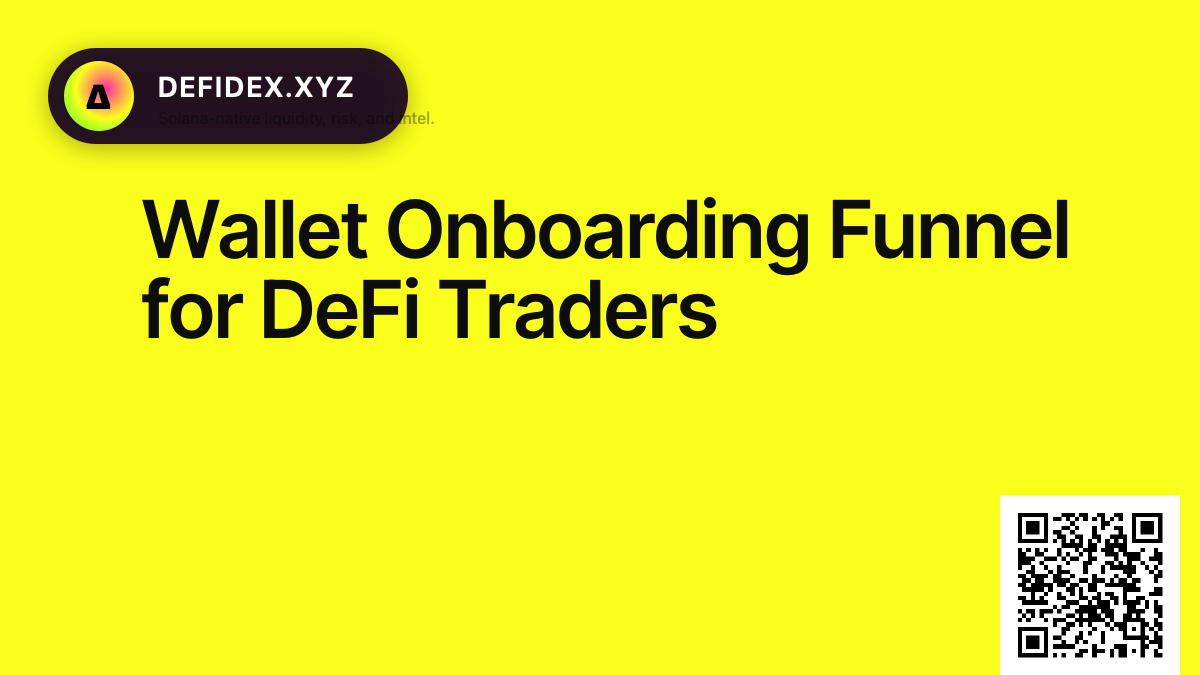Blog
Wallet Onboarding Funnel for DeFi Traders

Wallet onboarding is about confidence. When a Phantom or Solflare user opens your app they should immediately see a guided path, not a blank chart with a dozen neon buttons. We start with a device preflight: confirm the wallet extension is authentic, check for common malware signals, and measure latency to Solana RPC clusters. If anything feels sketchy we display clear instructions instead of cryptic errors. Passing the preflight triggers a “confidence meter” so users know they are operating in a safe environment before they ever move funds.
The next step is education wrapped in action. Rather than dumping users into documentation, we simulate a micro trade using devnet liquidity. The UI shows how collateral is deposited, how margin is reserved, how a perp order clears, and how PnL updates. Each animation links to a tiny knowledge card that explains the concept in one or two sentences. When the simulation finishes, the user can replay it or jump straight into mainnet with their newfound context.
KYC often ruins onboarding, but it does not have to. We use policy-based prompts: low-balance accounts can explore without friction, medium balances get light verification, and high-value accounts must complete full KYC before trading size. The prompts reference your compliance policy so support and legal stay synchronized. If a user tries to bypass requirements, the system politely blocks high-risk actions while still letting them browse analytics or educational modules.
Trust also hinges on transparency. We surface a personalized checklist that tracks funding, first trade, first withdrawal, security upgrades, and referral unlocks. Completing each item rewards the user with badges or fee discounts. More importantly, it tells them exactly where they stand—no hidden gating, no surprise KYC popups after they have already committed capital. When users understand the path, they move faster and churn less.
On the backend every state change flows into HubSpot, Salesforce, or your favorite CRM. Sales teams can see that an accelerator cohort finished onboarding but has not placed trades; compliance can see that a whale submitted documents but still awaits approval. Because the CRM timeline mirrors on-chain events, no one argues about what happened. Ops can even trigger nurture emails or in-app messages when a user stalls on a step for more than a day.
We also recommend an activation call-to-action inside the wallet extension itself. Solflare and Phantom support deep links that let you render custom panels. Use those to show the same checklist, highlight pending KYC tasks, or promote risk tips. The loop feels cohesive because the wallet, web app, and CRM all speak the same language about user progress.
Analytics complete the picture. We record funnel metrics—connect, fund, trade, withdraw—and slice them by acquisition channel. If a podcast ad brings wallet connectors but not trades, you know to tweak messaging. If a referral program produces high-quality deposits, you can double the rewards confidently. Because all data stems from on-chain truth, finance teams can reconcile marketing spend with actual trading revenue without begging engineers for ad hoc SQL reports.
Security is the final pillar. Encourage hardware signing, support multi-session approvals for funds that use MPC, and provide step-by-step instructions for rotating keys. When an account upgrades security, celebrate it in-app. The recognition reinforces good habits and signals to institutions that your platform values operational hygiene.
Finally, never let onboarding stagnate. Run quarterly audits of the funnel, watching real users via recorded sessions or live support co-browsing (with consent). Update copy, add new education modules when the product expands, and keep the CRM workflows current. Wallet onboarding is not a one-and-done project; it is a living map that evolves with the market, and DeFiDex gives you the instrumentation to steer it.
Looking ahead, we expect wallets to become more social. Prepare your onboarding for squad trading by letting users invite friends into shared workspaces with role-based permissions. Offer session replays so mentors can review a mentee’s first trades safely. Tie those collaborative features back into your CRM so growth, compliance, and support always know who is connected to whom. When onboarding respects relationships as much as individual wallets, your DEX feels like a community rather than a sterile interface.
Above all, measure sentiment. Prompt newcomers for a one-line vibe check after they finish onboarding. Feed those responses into product planning so you can spot friction before it tanks conversions. If users rave about the simulated trade, expand it. If they still fear gas fees or bridged assets, craft new lessons. Listening turns your onboarding map from a static flowchart into a co-created experience, and that is how DeFi breaks out of its niche.
Related intel
- blog Growth Stack for Wallets and Accelerators Distribution beats features, so we built a growth stack directly into the product. Wallets can white-label the interface, toggle referral …
- blog Compliance Checklist for Solana DEX Launches Launching a Solana DEX does not exempt you from mature compliance. Regulators increasingly treat non-custodial venues like brokers, and …
- blog Weekly Solana Perpetuals Funding Radar Funding drives trader behavior. Our radar ingests mark prices, index values, and realized funding from the largest Solana perps venues …
- blog Liquidity Cloud Architecture Explained The Liquidity Cloud is our connective tissue. Every market you expose—spot, perps, RFQ—registers with a routing contract that understands …
- blog Perp Terminal Blueprint for Solana Funds Perpetual traders crave CEX-grade tooling without the custodial baggage, and that tension is the entire reason this blueprint exists. A …
